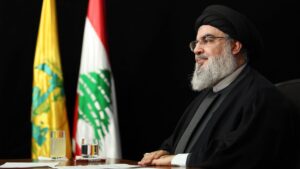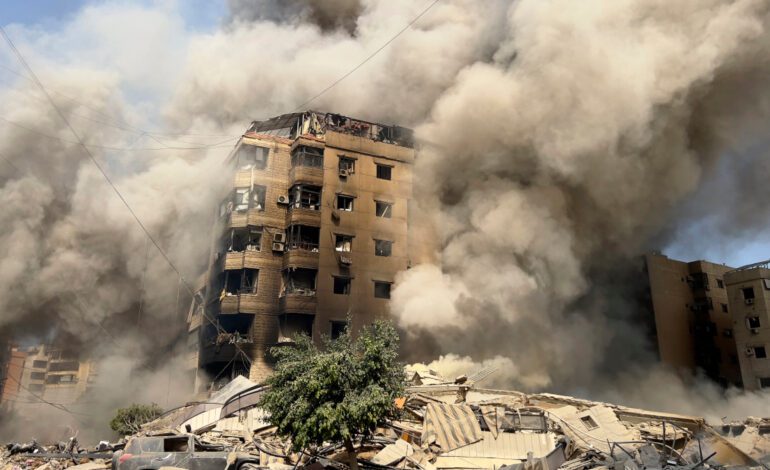Following Nasrallah’s assassination, which topped a series of Israeli military operations, including sabotaging communication devices and assassinating senior Hezbollah military leaders, Israel expanded its aggression on Lebanon. By Monday evening, Israel announced the start of a “limited” ground operation inside Lebanese territory. However, by the following evening, Netanyahu’s vision of victory started to crumble. A Palestinian martyrdom operation took place in Jaffa, coinciding with the largest missile attack Israel has faced since its establishment. Iran launched around 200 ballistic missiles, targeting military sites in central and southern occupied Palestine, with leaked video footage showing Israeli air defenses struggling to repel the unexpected attack. This revealed a glimpse of Iran’s capabilities, along with the broader Resistance Axis.
Despite Israel’s attempts to downplay the severity of the situation to maintain its deterrence credibility, the true source of fear for Netanyahu and Israelis came just hours later. Early Wednesday morning, during the first attempts to advance into Lebanese territory, Israeli elite forces suffered significant losses at the hands of Hezbollah fighters, who were eager to avenge Nasrallah’s assassination. Nasrallah had previously vowed that any Israeli soldiers entering Lebanese land would be sent back “horizontally,” a promise confirmed by footage showing helicopters rushing to evacuate dozens of wounded soldiers to hospitals.
The resistance confronts the Israeli army at the borders, inflicting dozens of casualties and injuries
The initial ground confrontations between Hezbollah and the Israeli elite forces demonstrated the resistance’s readiness and ability to maintain its preparedness despite the severe blows it had suffered over the preceding two weeks, culminating in Nasrallah’s assassination. This resilience was also evident in the continued missile attacks on Israeli military and intelligence bases, as well as targeting Israeli troop movements behind the border.
In Lebanon, despite the great loss from the martyrdom of the Resistance leader, Hezbollah’s Deputy Secretary-General Sheikh Naim Qassem confirmed that the leadership, control and command structures remained intact, as did the military infrastructure. He added that all Hezbollah commanders positions left vacant by the assassinations had been properly and swiftly filled, and a new secretary-general would be selected “at the earliest opportunity.”
Qassem emphasized that Hezbollah would continue with the strategies laid out by Nasrallah, including preventing Israeli settlers from returning to their northern villages and towns until the war on the Palestinians in Gaza had ended.

NASRALLAH’S ASSASSINATION FUELS RESISTANCE
On Saturday, the Jerusalem Post published details of what it described as a “secret and complex” operation. Citing security sources, the report stated that “the political, intelligence and operational conditions for Nasrallah’s assassination had matured by Wednesday, September 25, leading military intelligence to once again recommend action. The political leadership agreed after reviewing sensitive intelligence gathered to close the loop.” According to Maariv, “Netanyahu gave the green light for advancing the ceasefire process and decided to travel to the United States, in what appeared to be a deceptive maneuver. During the flight, security consultations were held on board, with intelligence updates provided about developments in Lebanon and the readiness of intelligence and air forces to carry out an attack from which no one could escape, even in underground bunker.”
The operation that claimed the lives of several other leaders close to Nasrallah took place before Netanyahu’s speech at the United Nations General Assembly, where he addressed a nearly empty hall after many delegations left in protest of his war crimes. However, Netanyahu’s overconfidence led him to enthusiastically promote the reshaping of the Middle East according to Israel’s vision, brandishing a map that notably omitted Gaza and the West Bank, implicitly signaling his intent to eliminate all Palestinian rights.
Iranian strike and the war’s expansion
On October 1, Iran stunned the world by showcasing its actual power with the largest air assault on Israel since its establishment, in retaliation for the assassinations of Nasrallah, Hamas leader Ismail Haniyeh and the deputy commander of the Revolutionary Guards, Abbas Nilforoushan.
The Iranian attack involved more than 200 ballistic missiles, which Tehran described as a “warning” to Israel against crossing red lines, with promises of devastating retaliation for any Israeli response. Iranian President Masoud Pezeshkian stated that the missile strike was in defense of Iran’s interests and citizens and a lawful response to Haniyeh’s assassination in Tehran. He noted that the attack was “only a part of our strength.”
Iranian officials explained that the attack came after a prolonged period of restraint, driven by efforts to secure a ceasefire in Gaza, which turned out to be a diplomatic ruse favoring Tel Aviv. Iran’s supreme leader, Ayatollah Ali Khamenei, warned that “the strikes against Israel will become stronger and more painful, targeting the decaying and rotten Zionist regime.”
Unlike the previous Iranian strike in April, the Israeli military was forced this time to admit that several of its airbases had been damaged. Video clips circulated showing missiles raining down on their targets in multiple areas, including the outskirts of Tel Aviv, the Negev Desert and near the Gaza Strip.
Netanyahu quickly vowed to retaliate against Iran, while Washington rushed to calm Tel Aviv’s anger in an effort to prevent the war from escalating further, especially given the risk of targeting Iranian nuclear facilities.
President Biden assured that the U.S. would continue to support and protect Israel, expressing confidence in avoiding a full-scale war in the Middle East, though he acknowledged that “there is still much work to be done.”
Similarly, Democratic presidential candidate Kamala Harris reaffirmed Washington’s commitment to Israel’s security, stating, “I will always ensure Israel’s ability to defend itself against Iran and its supported terrorist militias.”
Meanwhile, other fronts supporting Gaza, including those in Yemen and Iraq, continued launching daily attacks deep inside Israel, using long-range missiles and drones. Additionally, the Houthis in Yemen intensified their targeting of U.S. and British naval vessels, while Syria faced new Israeli airstrikes in the northern region near the Russian Khmeimim airbase. These developments suggest Netanyahu’s strong desire to expand the war and provoke direct U.S. intervention, beyond the financial, political and military support already provided by Washington and its allies.
Gaza and the West Bank
As ground confrontations with Hezbollah started on the northern front, Israeli media began discussing the possibility of halting a ground invasion, calling it “the deep, deadly Lebanese quagmire.” They were reconsidering this after dealing with almost a year of trying to control Gaza, which resulted in massive destruction and widespread displacement. Despite all of this, Palestinian resistance in Gaza remained strong, showcasing several attacks on Israeli army last week.
While resistance operations inside Gaza continued, Israel suffered a big blow in Tel Aviv when two Hamas fighters from the West Bank attacked Israelis at a train station, killing seven and wounding 16. In retaliation, Israel carried out an airstrike on a café in the Tulkarm Refugee Camp on Thursday, killing 18 Palestinians. This was the first time Israeli warplanes targeted the West Bank since the Second Intifada in 2002.
A failed invasion
In Lebanon, early last Wednesday, Israel’s highly anticipated ground operation finally became a reality, but quickly fell apart. Elite Israeli troops, particularly the “Egoz” unit, were ambushed by Hezbollah fighters near the border village of Adaisseh, right after advancing from the settlement of Misgav Am. It was a brutal ambush, and Israeli media described it as a “sad day” in Israel’s history. For the next two days, Hezbollah targeted Israeli military movements behind the Blue Line, even reaching areas north of Haifa.
Israel’s Channel 12 acknowledged that the “ground maneuver came at a high cost in lives” and mentioned that Hezbollah had prepared some “unwelcome and very harsh surprises” for the Israeli army. Former Israeli Prime Minister Ehud Olmert also chimed in, saying, “What we’re doing now won’t bring the northern residents back home; we’ll be stuck for a long time with severe losses in Lebanon.” Channel 24 called the situation a “small reminder of the cost of fighting in southern Lebanon”, while Israel’s Defense Minister Yoav Gallant said the losses in Lebanon represent “the heavy cost of the most just war Israel has ever fought.” Even Netanyahu had to admit, “We are in the midst of a tough war.”
In just two days of fighting, dozens of Israeli soldiers and officers were killed or wounded in ambushes by Hezbollah fighters along the border in areas between Kfarkela, Adaisseh, Yaroun, Maroun al-Ras, and Aitaroun. Israeli media remained largely silent, only admitting to the death of one soldier and the injury of around 40 soldiers. On the first day alone, they acknowledged the deaths of eight soldiers, while 35 others were injured. According to Hezbollah sources, on the second day, the casualty count rose to 17 dead Israeli soldiers and officers, with dozens more injured.
The resistance’s strategy to confront the Israeli ground incursion revealed a well-prepared plan: setting up ambushes, bombing supply lines and attacking troop gatherings before they advance. This showed that Hezbollah had pre-planned strategies to face the invasion and maintained control of the ground with defensive and supportive units.
Israeli retaliation
As usual, like a cornered beast, Israel expanded its aggression on Lebanon, targeting areas to create a massive displacement crisis, even striking deeper into Beirut. By Thursday, Israel had launched two airstrikes on the Lebanese capital. The bombardment was calculated, using toxic phosphorus in some missiles fired from naval warships, aiming to clear large areas of their residents, especially in the south, Bekaa and Beirut’s southern suburbs.
The estimated number of displaced people from Israel’s onslaught reached around two million. While all international airlines suspended their flights to Beirut’s airport, Lebanese Middle East Airlines continued to fly thousands out of the country daily. Meanwhile, Israel tightened its siege on Lebanon by bombing the international road connecting Lebanon and Syria near the Masnaa crossing.
Throughout the past week, Israeli warplanes systematically targeted the Lebanese Red Cross and civil defense teams, both in the south and even in Beirut. Not only were mobile medical teams targeted while evacuating the dead and wounded, but Israel also bombed their stations in residential areas, killing medical crews, as seen in the attack on the Islamic Health Organization in Beirut’s Bashoura district.
With Israel failing to break Hezbollah’s resolve at the border, it shifted its focus back to targeting the party’s leadership. On Thursday night, massive explosions echoed across southern Beirut, with Israeli airstrikes hitting buildings in the Lilaky and Mreijeh areas, causing significant destruction.
Shortly after, leaks surfaced across Israeli, American and Arab media that the attack aimed to assassinate Sayyed Hashem Safieddine, the head of Hezbollah’s Executive Council and the most likely successor to Nasrallah. Israeli military and security sources hinted that the strike targeted “an underground location”, drawing parallels to the operation that killed Nasrallah the previous week. However, The Arab American News could not confirm or deny the Israeli claims, and Hezbollah has yet to issue a statement about the attack.






Leave a Reply